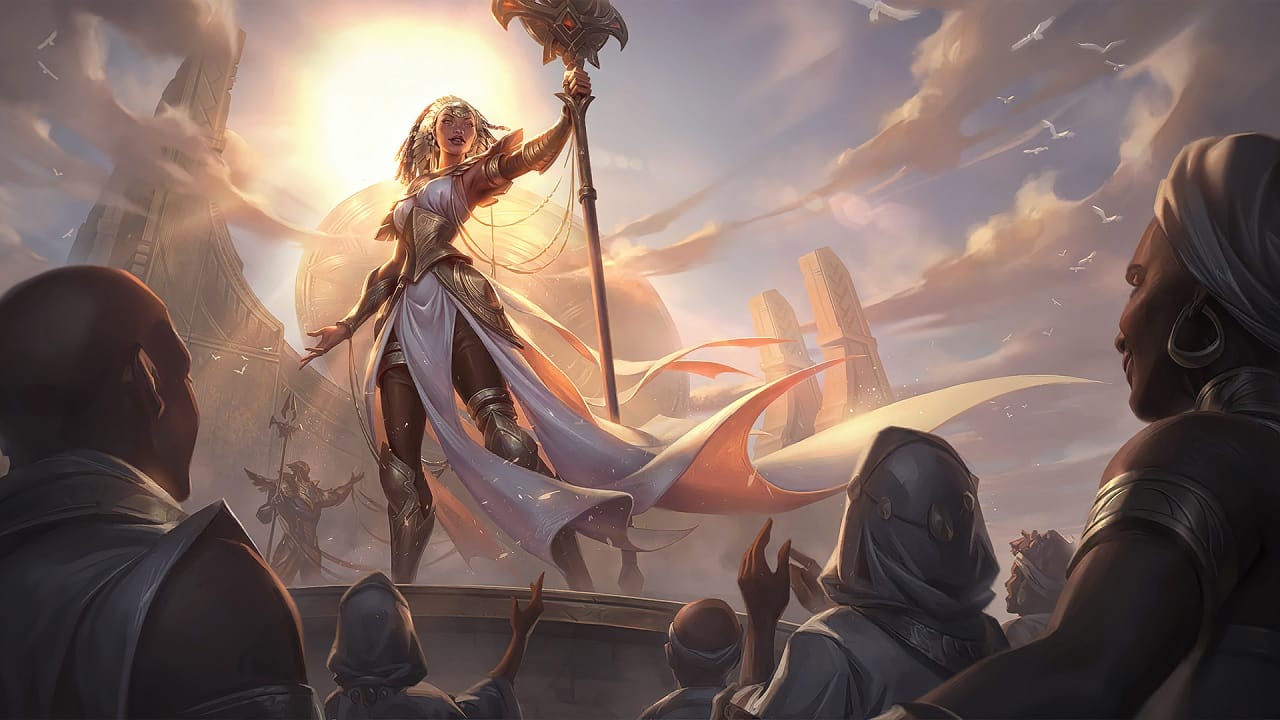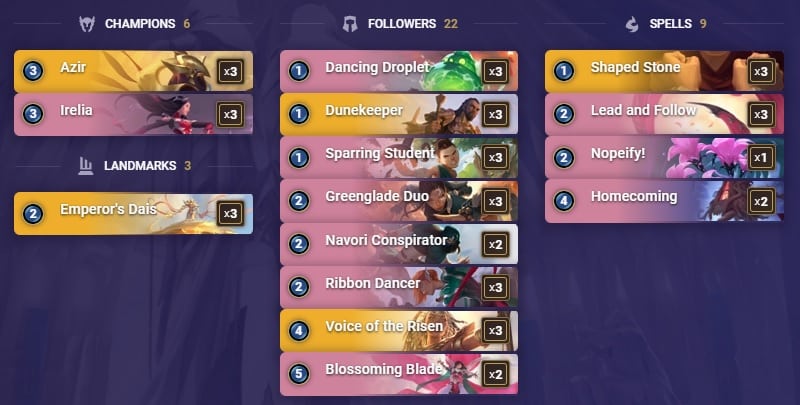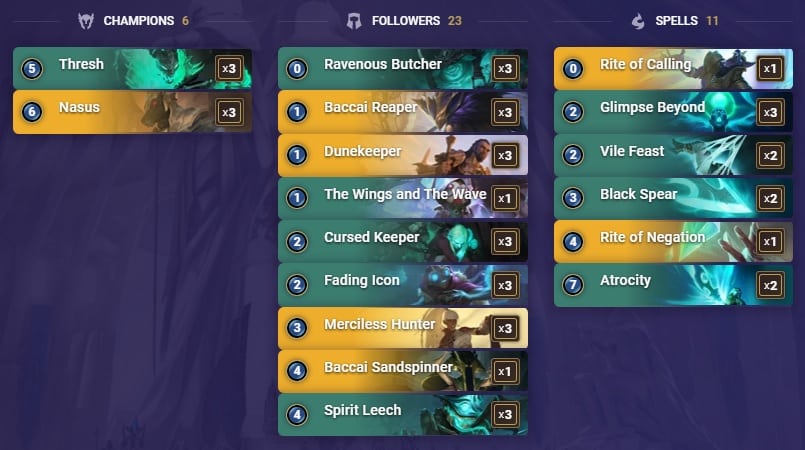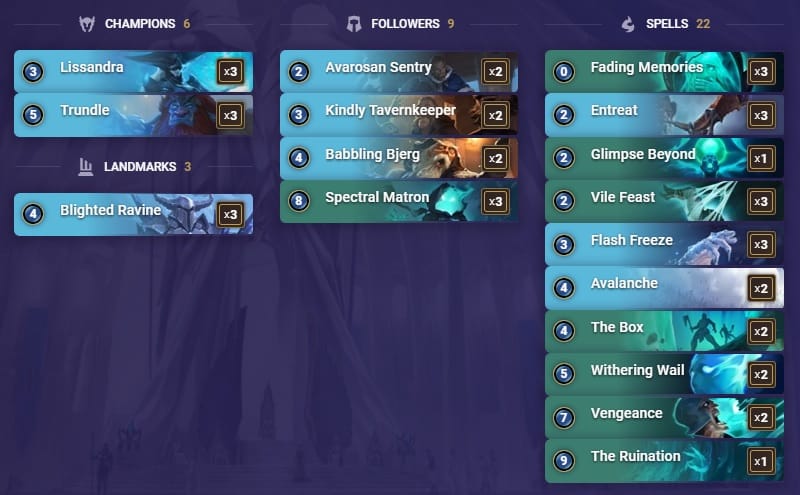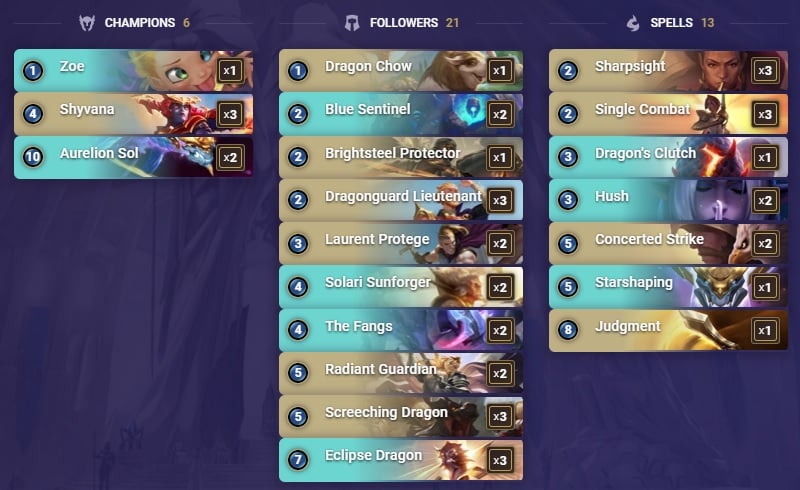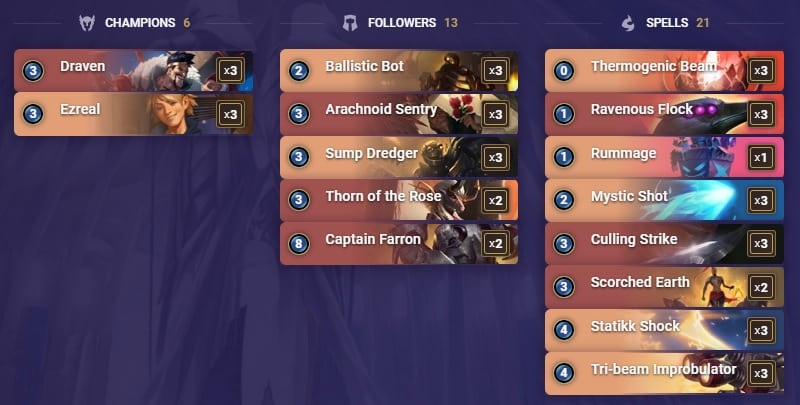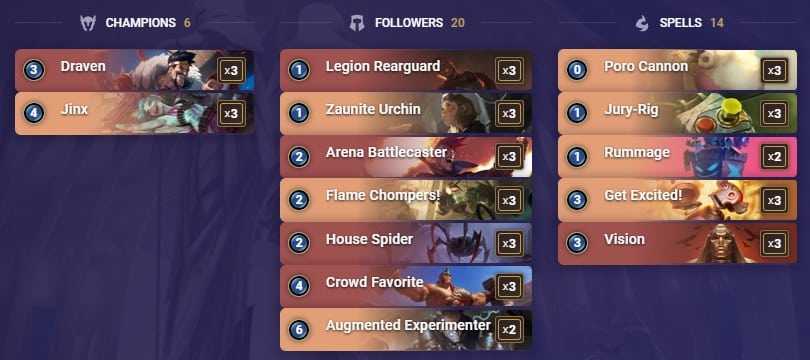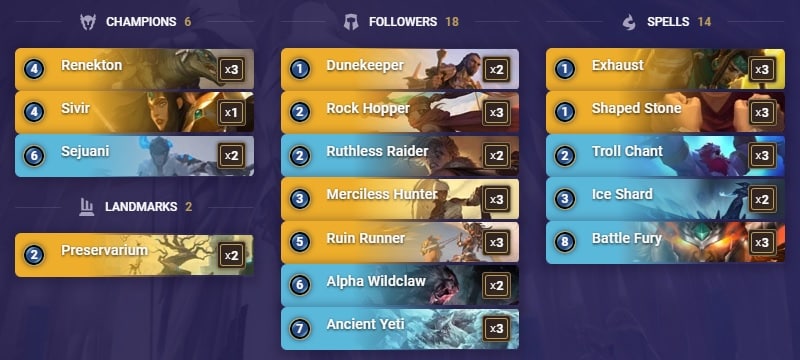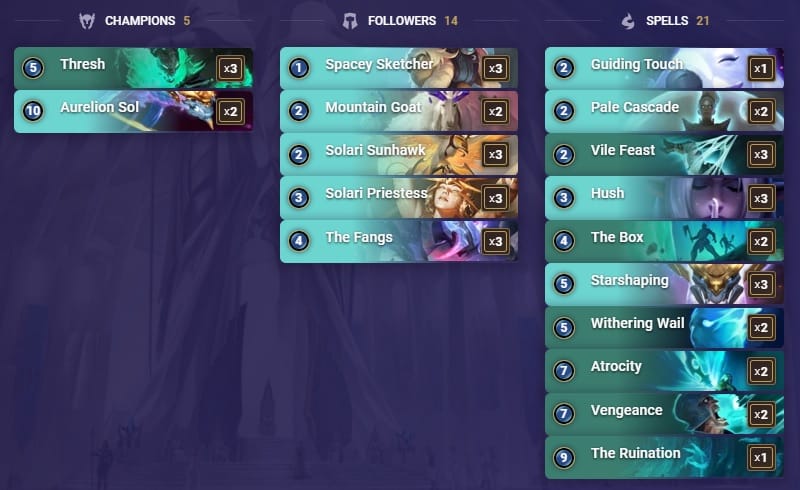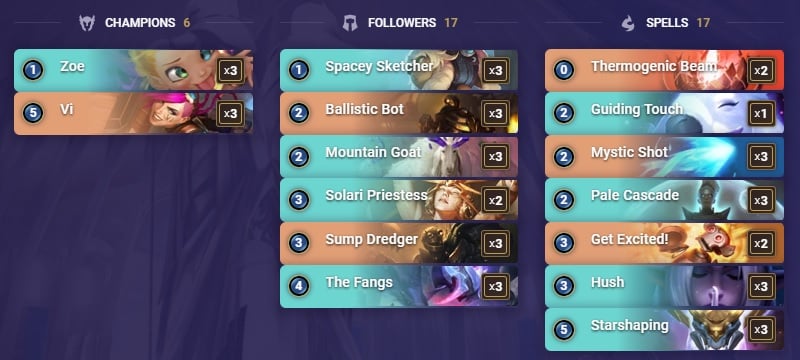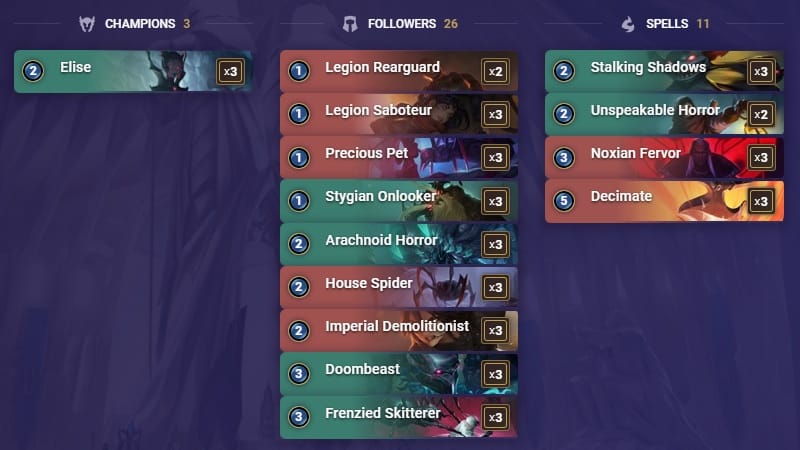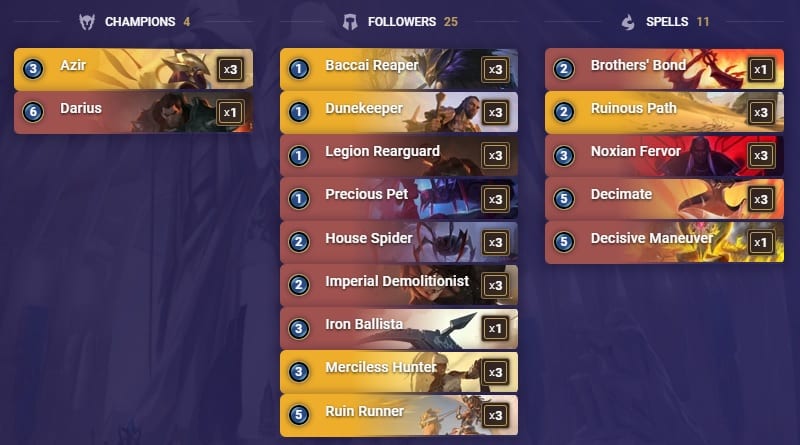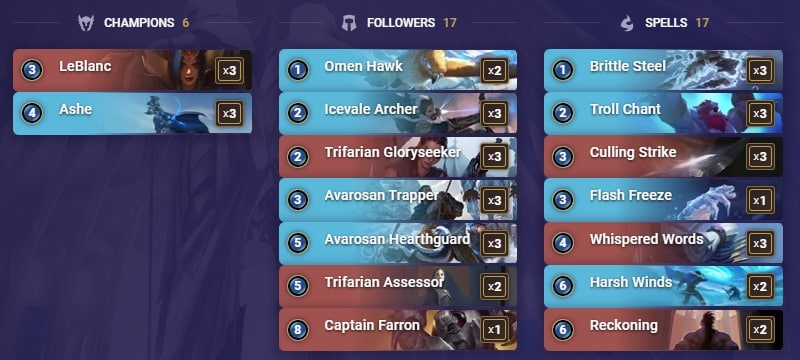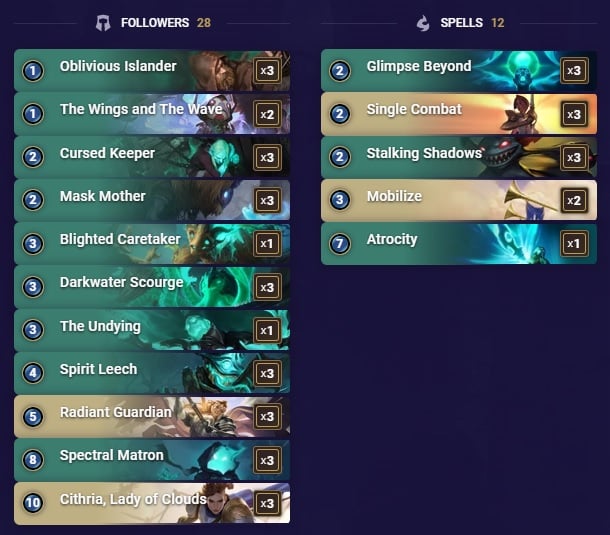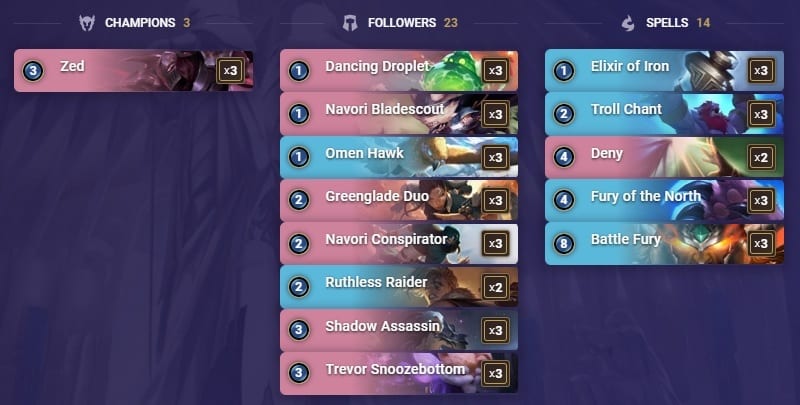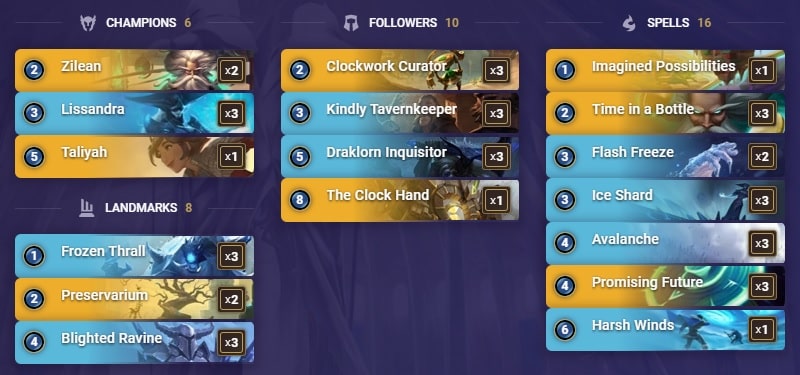Welcome to TLG’s latest meta snapshot for Legends of Runeterra, a series in which we give you our insight on the finest decks in the higher ranks of the ladder.
Every Monday, we discuss the decks that are part of the week’s meta and rate them on a scale of 1 to 5 stars. We also look at the evolution of said decks’ ratings across weeks and draw conclusions regarding the current state of the game, all of this so you can delve into your own ranked journey with a head start.
Heartbreakingly, the hefty balance patch we all wanted and needed didn’t materialize. There were a few minor changes that may affect Azir-Irelia’s curve, but it’s unlikely that much will change overall. That said, we have updated the decklists and write-ups to reflect how we expect the next couple of weeks to play out.
If you have any questions, feel free to drop by our Discord. Best of luck on your climb!
Graphics: WellMax81
Editing: Wusubi, Sebodunum
Writers: Den, Ultraman, Othal

CMBQEAICAYVAIBACAUEQWDYFAQDQGGRTJVOQGAIBAIWACAYCAUAQIAQEAEAQGAQU
Difficulty: Easy
Azir-Irelia has quickly become one of the most debated decks in the history of the game, with crazy highs and frustrating lows, leaving players dissatisfied when both playing with it and against it. The deck reached an incredibly high playrate and winrate before Patch 2.9, but was left almost entirely intact, with both its curve and power level largely unchanged.
This deck is a relentless attacker, using (and abusing) Azir and Emperor’s Dais to create multiple tokens, swarming the board until your opponent has no blockers left to protect their Nexus. This could happen in two ways, either because your opponent overreacted and used too much of their mana, or because you had too many answers for their own responses.
Because, yes, this is Ionia. And as soon as you’re ahead, you get to dictate the pace of the game, forcing the opposition to play proactively, then punishing them for doing so. In the subtle words of BoJack Horseman’s writers:
“Are you punishing me for smoking or for stealing?”
“I’m punishing you for being alive.”
Azir-Irelia punishes you for being alive, basically. Until you aren’t anymore. They’ll punish you with the likes of Lead and Follow, Nopeify! sometimes Retreat if they run it, Shaped Stone... If you land a removal, you better celebrate.
The sole known way of defeating this great evil is, quite simply, outpacing it. Aggressive decks can do that and Thresh-Nasus can still do it better than anyone. The presence of Thresh as a tutor for Nasus also helps with stopping the waves of attackers, since even Ionia fears the power of the almighty Doggo. (Write-up by Ultraman)

CMBQEBAFAMIAIAIFBMYDCNAEAQDQEGRPM4AQGAIFDERCQAQBAQCQIAYEA45VC6I
Difficulty: Easy
Thresh-Nasus remains one of the best archetypes as of now, despite the nerfs to Atrocity and Blighted Caretaker. The addition of Merciless Hunter helps dealing with threats earlier (e.g. Ezreal) and allows you to make value trades, as her presence usually requires two cards from your opponent to be handled.
The early tempo of Ravenous Butcher, Cursed Keeper, Blighted Caretaker and Dunekeeper is still unmatched, granting you a great opener with which you can transition into Thresh. If your opponent fails to answer the early pressure, they’ll have to kill both your minions and Thresh. This will force them into suboptimal removals which can be punished with Glimpse Beyond, Black Spear, Rite of Negation or Vile Feast.
And even if the opponent manages to withstand the early storm, they’ll still have to deal with Nasus. Depending on the deck you’re facing, Nasus can prove an insurmountable threat or a Hush target. Either way, though, his pressure is undeniable and Atrocity will still obliterate the opposing Nexus, even if it costs one more mana now.
Ezreal-Draven especially struggles to answer Nasus - the deck can’t destroy him immediately, so he should be able to level-up and get Spellshield. Once this happens, you can kill them by responding to any spells thrown at you with Atrocity.
Thresh-Nasus also does quite well into Azir-Irelia, mainly by having access to a lot of early tempo, pressuring them while also taking advantage of the swarming Blade tokens playing directly into the hands of your champions. (Write-up by Ultraman)
CECACAYBAYBACAIBDUBAIAIFBYBQCBJIFQXQEAYBAUARGHIEAEAQGBYUGIAQEAIFB4YQ
Difficulty: Moderate
Even if Azir-Irelia is a hotly debated topic, it had one at least one positive effect: it managed to stop the Ice Queen’s domination. Trundle-Lissandra Control (TLC) is an archetype that has been especially effective in dealing with almost everything the meta has to offer and would probably be the best deck on ladder if not for the high playrate of Azir-Irelia.
The list has been perfected through ladder and tournament play, and it doesn’t feel like anything new is needed for this deck to perform. The Freljord wide punish package prevents most swarm decks from developing optimally in the first 4 or 5 turns and Vengeance or the single copy of The Ruination are great punishers in the late game against Midrange builds.
TLC packs a lot of draw and can speedrun its combo against other slow decks, many of which aren’t found on ladder right now anyway, due to the extreme aggression of Azir-Irelia. Basically, TLC doesn’t fear most control-oriented matchups when it comes to reaching its win condition first. (Write-up by Othal)
CIBQCAIADIAQGCLEAQBQABQIBMHAIAICAAAQCBAJAQBACAALB4CAGCJZKVL52AIDAECAADQCAEAAOCIDAMEQGCKU
Difficulty: Easy
Shyvana and her kin are trending, being able to answer Thresh-Nasus while retaining competitiveness against other popular decks, despite being statistically behind. Quite the conundrum, but fear not, all you have to do is replicate what the Top 10 players show you: play perfectly, and win. Simple recipe in theory, now for the practice...
This deck has ways of answering most opponents, but it requires you to anticipate most of their plays, as almost everything you do is heavy-handed in terms of mana and consequently doesn’t leave any room for error. One miscalculation can be the reason you won’t be able to use Concerted Strike on Turn 8, which can result in a threat getting through your blockers.
Blue Sentinel is strong at stopping the likes of Thresh-Nasus from attacking, as its potential to grant you a Shyvana on Turn 3 should be terrifying for the opponent. Your mid game is good, thanks to combat tricks such as Sharpsight, or just the regular Shyvana into Screeching Dragon play, helping you take back the board from your pesky opponent’s claws.
It must be said that Shyvana has bad matchups against most of the Tier 1 decks, statistically speaking, despite being built to resist the likes of Azir-Irelia, due to the Fury keyword and Radiant Guardian.
Make sure you mulligan for the early game, and don’t hesitate to greed in order to find your win cons. These are ASol against control decks, Hush vs Thresh-Nasus and Laurent Protege, Radiant Guardian or Shyvana vs Azir-Irelia! (Write-up by Ultraman)
CECACAQDBEBAGBAFCEBQCAYECQXAKAIEDMPSIJRUAMAQCAZTAEBQGDIBAQBQUAIBAECAC
Difficulty: Easy
As each and every season, Ezreal-Draven shines as the anti-fun archetype, wheeled out by players wanting to stamp out those experimenting with new or unoptimized lists. Like a tough old veteran warming up the new trainees, this deck won’t take any of your bullshit. It’s strong and stable, with the ability to remove many threats and switch to more control or aggression-based gameplay depending on the deck it’s facing.
Matchup-wise, the ol’ man struggles against quite a few of the more-established decks, including TLC and Thresh-Nasus, but it compensates for this by utterly destroying any deck that tries to win through board pressure. Watch as the Demacians fall, one after the other, while Freljord Midrange suffers a similar fate.
Against your bad matchups, Ezreal will be your best bet, as he can take advantage of even the smallest window of opportunity once flipped to deal significant Nexus damage. If the opponent ignores him and tries to go for any combo play, you can punish them and take the game with the right tools in hand. (Write-up by Ultraman)

CEBQCAYECICQCBAMDQTSQLIGAEBQOCIMCQTTOAICAECACDIA
Difficulty: Moderate
The patch arrived earlier this week and nothing suggests to us that Azir-Irelia will diminish in popularity or power level in the coming days. It’s only logical that one of its biggest counters still makes sense in the current meta. Although outshined by a more stable Noxus/Piltover combination in the form of Ezreal-Draven, Discard Aggro remains a relevant deck and forces other lists to account for hyper aggressive strategies.
The deck has shifted toward a more board-centric strategy, with the return of triple Arena Battlecaster for example, a strategy that floods the board with units and overwhelms the opponent with damage, something that Azir-Irelia struggles against.
Obviously, that induces sacrifices in other matchups and most Freljord decks with triple Avalanche are capable of destroying the crucial early game the deck looks to establish, but as long as some of the better decks won’t be able to handle that kind of aggression, Discard Aggro should still find a reason to be played.
The now board-centric core forces a more high-risk, high-reward kind of gameplay, especially in the earlier portion of the game, which puts the emphasis on mastering the mulligan phase and being alert to the types of defensive tools your opponent could have access to.
If the early aggression finds the opposing Nexus, it’s usually a clear sign of a game well-engaged and on the right tracks, where transitioning to Draven, Jinx or Crowd Favorite is a great power move that our opponent needs a perfect answer to in order to simply stay in the game. When that phase gets stalled, the deck can feel like it lacks the tools to rebuild the pressure outside of drawing the two champions or an Augmented Experimenter to refill our hand.
For those reasons, Discard Aggro looks like it has a good place in the meta, but could be losing some of its old aura as an overall powerful list, morphing to now fit more into the role of a counter-pick to some of the dominant decks. (Write-up by den)
CMBQCAYBAIBACAIFD4DAIBZGFU3UGXLHAQAQCAI2AECACCICAIAQEBQCAQDQ2GQBAECAOFA
Difficulty: Easy
With the addition of Merciless Hunter, Renekton has found one more ally to join his cause. Having an effective 3-drop gives the deck a better curve and helps the Overwhelm mechanic pick its battles more effectively, which of course directly translates into achieving more Nexus damage over time and better trades in the Midrange matchups.
With average to good matchups against the current juggernauts (TLC, Thresh-Nasus, Ezreal-Draven) the deck looks like it could be a solid pick across the board, and several players have trusted it to climb the ladder or even to bring it to some tournaments like Fight Night or EU Masters.
The list presented here is a bit different from the usual ones, as Dunekeeper feels great instead of Omen Hawk (better blocking ability and 2 targets instead of 1 for a Battle Fury in the late game). Ice Shard helps against Aggro decks and allows you to push for more damage, weakening their defenses to get more Overwhelm damage during an attack.
If you want to pick up this deck, we recommend working on timing your attacks. It’s easy to go for big damage turns, but that can be at the sacrifice of the defensive part of the game, which is also very important to consider in order to ensure that you’re the one applying the pressure.
This will help you avoid entering into a damage race which isn’t so easy to win considering we have no healing and no direct damage from hand. Having good timing on when to start looking to push damage will allow you to keep your own allies and Nexus healthy, making a lot of decisions much easier down the line. (Write-up by den)
CIBQCBAJBUBACBJIGQCQGCKUKVLGBXIBAIBQGCJDK5OAIAIFAEJRSHICAEAQKDYBAMETG
Difficulty: Moderate
In the midst of EU Masters, an old deck emerged after being in slumber for a year or so. Thresh-ASol was never too effective, and while it saw some play at the start of the Targon expansion, it was soon overtaken by the likes of Trundle-ASol (prior to Trundle’s nerf) and then Zoe versions, such as Zoe-Diana, Zoe-Vi or Zoe-ASol.
As Azir-Irelia has decimated most of Targon’s archetypes, from Lee Sin to Zoe variants, Zoe-ASol had to adapt in order to block more efficiently. It was the birth, or rather, the competitive birth of Shyvana-ASol, a well-loved archetype and fan favorite since Shyvana’s addition into the game.
It was soon obvious that what we thought was a counter simply wasn’t enough - we needed more control and more reactivity. The Targon equation in this meta was always one of destroying Thresh-Nasus, while losing to TLC and Azir-Irelia. Some versions could beat EZ-Draven, but you would still end up in a stalemate. As such, the situation was one of going back and forth having to rely on seeing more Thresh-Nasus than Azir-Irelia in order to climb.
This deck adds more removals and healing to survive long enough for Azir-Irelia to tire itself out. Thresh discourages opponents from attacking you, not wanting to risk an early appearance from ASol. This usually allows you to stabilize the board state and keep enough mana for your removals. (Write-up by Ultraman)
CICACAQEBAAQGBAFAIAQIJRUA4BQSCJDKRKVMXG5AEBACAYJMABACBA3E4AQCAYJGM
Difficulty: Hard
The Celestial synergy has lost a lot of its power over the last few months, going from the heights of being one of the best in the game all the way down to a support role in counter-pick decks. One of these decks is Zoe-Vi, a deck that relies on Piltover spells and Vi to be solid on the board and answer what the opponent throws at them. The Targon region is in charge of building some value and setting the deck for the late game.
The deck was at first picked to counter Thresh-Nasus due to its ability to pack triple Hush for Nasus and cheap spells to reduce the early pressure. The Invoke and heal package allow you to push the game to a late stage, potentially punishing Thresh-Nasus if it doesn’t draw well enough to sustain its pressure until that point. The Invoke package can also be good in other matchups, as for example the Elusive and/or Spellshield keywords can be powerful against control decks such as TLC.
The problems arise when playing against tempo decks that force you to be able to play on curve or answer threats, as the deck aims for a more on curve, steady developing gameplay. This is the main limit to the deck’s success.
Its lack of explosiveness means the opponent can pull ahead so far that Zoe-Vi will struggle to catch up with them. Once that gap is created, most of the deck’s synergies fall apart, as the Celestial Invokes demand too much mana to be created, Vi can be ignored and the spells are only helping to slow down rather than solve the issue.
This is something that can be helped in a tournament environment, where the deck can be protected with a ban, in order to remove some of the too-explosive-to-contain decks roaming the ladder. This setup also allows the player to orient the deck towards either its late game potential or reinforce its defensive capabilities through spells, helping the deck even more in the matchups you’re aiming to target.
On ladder, unfortunately, the deck can’t rely on controlling those aspects, making it a difficult pick for reliable climbing without a little luck when it comes to the matchups encountered along the way. (Write-up by den)
CMCAEAQDAMCAGAIFE42TQAYDAUBQIBQEAEBQEDZIG4BACAIDBQAQGBICAA
Difficulty: Easy
In a meta overwhelmed by Azir-Irelia, you either need to survive or be faster than them. And there’s hardly any deck faster than Elise Burn. With its numerous low-cost units and synergies, the deck can apply a lot of pressure before delivering the finishing blow through direct Burn damage.
This game plan is supported by a flurry of cards that allow you to overwhelm your opponent’s defenses before they can even think about playing to their win conditions. Your cheap units are straightforward and have some additional and bothersome effects. For example, Precious Pet is a 1-drop Fearsome, while Legion Saboteur’s ability helps you whittle down the opposing Nexus every time it attacks.
Always keep track of the amount of Spiders you have - while it’s not a straight win condition, getting Elise to evolve can change the whole board with small Spiders challenging enemy units to allow the bigger Fearsome creatures to go through unblocked. These Fearsome units are a key part of the deck, with most decks in the meta lacking solutions to tackle them early on.
While Precious Pet and Arachnoid Horror are very dangerous, Stygian Onlooker can push 4 damage straight to the opponent’s Nexus for just 1 mana, all on its own if played correctly. And if your Fearsome units look like they can’t go through the blockers, worry not: Frenzied Skitterer will help. Not only will it boost Spiders, it can make the opposing units go under the 3 attack mark, giving you a free turn of attack for your Fearsomes to feast on.
It’s Turn 3 or 4, your opponent has too many blockers and your board can’t get any meaningful damage in? Well, that’s why this deck is a Burn deck and not solely a board-based Aggro one. Even the first couple of turns can allow you to get the opponent’s Nexus low enough for the Burn cards to start doing their job.
Decimate, Doombeast and Imperial Demolitionist are all cards that will be able to seal the deal, while Noxian Fervor is a great reaction card to use when your opponent tries to remove or favourably block one of your units.
The most complicated card to use in this deck, and one of the strongest ones, is Stalking Shadows. It offers a lot of flexibility, so you will need to understand which unit is the best option. Should you go for a double Doombeast to Burn the opposing Nexus, or for a double Stygian Onlooker to have two 4/1 Fearsomes for your attack turn? Or maybe you need another Frenzied Skitterer to make sure there are no blockers left? (Write-up by Othal)
CEBQEAQDAMCAIAIDAIGA6NYGAQDQEAY2G5JGOAACAEBAGBIDAEBQ2GJG
Difficulty: Easy
Some consider this deck to be a worse version of Discard Aggro, while others believe that it’s not even worth trying to play Azir anywhere else than with Irelia in the current state of things. Personally, I consider this archetype to be one of the few with some deckbuilding possibilities left, as it feels the best 40 cards still haven’t been figured out.
There isn’t too much nuance to its actual gameplay, which is heavily damaging the opposing Nexus through early pressure and transitioning to direct damage later in the game, but that doesn’t mean it can’t be flexible nonetheless.
Shurima and Noxus have hands down been the two best Aggro regions of the current meta and when they’re mixed together, they can be scary to go against. In many ways, they feel reminiscent of Pirates Aggro days except with Sand Soldiers instead of MF and Gangplank’s armies.
Just like the deck it’s most often compared to, Discard Aggro, Azir Burn is capable of beating down anyone in the early game, leaving its opponents in fear of a well-timed Decimate. But as time progresses, the deck has also found some balance when it comes to building pressure over time instead of solely relying on an incredibly explosive start.
Cards like Decisive Maneuver or Brothers’ Bond have given the deck more flexibility with regard to the ways it can develop the board, while there have been some substitutions with the units in the list, like Iron Ballista coming in. Most importantly, it also keeps the opponent on their toes, which is something that the deck has failed to do in the past, where it was basically aiming to build maximum pressure every time, making it extremely predictable.
On ladder, the deck has been fairly quiet lately, as Thresh-Nasus was punishing it heavily. However, it’s undeniable that the deck is still one of the better pure damage-oriented lists out there, and with a recent resurgence of Elise Burn, there’s no reason for Azir Burn not to be an interesting pick as well. (Write-up by den)

CMCAEAIDAQPQEBADAICAKAIBBMPCMKJQAEBQCAQCAIAQCFRKAIAQGIJVAIAQCAIBAEAQGMY
Difficulty: Easy
Ashe and LeBlanc make for a perfect pair, each of them being 5+ attack champions, both helping each other gain Reputation and card draw in the form of Trifarian Assessor and Whispered Words.
It’s useful to have more bodies that can activate Reckoning - this card is crucial to survive against Aggro and Midrange decks. Those two archetypes are, paradoxically, both the reason Frostbite is able to perform and the reason it doesn’t perform too well in the current ladder environment.
With the multitude of aggressive decks out there, this list has trouble staying alive. The combination Freljord and Noxus lacks healing and cheap removal to deal with the swarm of minions that’s so often seen on the ladder at the moment.
On the other hand, it has a great matchup against decks that focus on trading, such as Demacian decks. It also has a decent matchup against Lee Sin, due to its Freeze cards, but can often sometimes to finish the game unless a well-timed Reckoning can avoid the opponent’s Deny. (Write-up by Ultraman)
CECQCAYFAQAQIAAFAIAQADY2AICAKDIQAUAQKBAMFQYDCAQBAEABGAIEAUCAEAICAUCAEAIFDEUQ
Difficulty: Medium
Card games are a battle of numbers. In a lot of cases, the player getting the bigger numbers is at an advantage. It’s upon this foundation that the Cithria-Matron Combo (CMC) deck is built, as Cithria, Lady of Clouds doubles the power and health of her allies when summoned, while also granting them Challenger. The deck isn’t contending for anything close to Tier 1, but it has been gaining some popularity on ladder and could eventually become a decent option in the current meta.
The game plan revolves around aiming to slow down the pace of the early and mid game in order to dominate the late game thanks to several appearances from Cithria. To achieve that, the deck uses units that force the opponent to hold their attacks, change their development plans and focus on removing units that’ll become a problem once buffed up. The two key units in this role are Radiant Guardian and Mask Mother.
However, the deck is a bit unreliable and lacks removal outside of Single Combat, a card which is difficult to use before having one of the two previously mentioned units installed on the board. As such, most decks just play their own game plan without really giving much respect to what CMC can accomplish before reaching that Spectral Matron turn, and it usually is the right way to approach the matchup. (Write-up by den)
CEDACAQBA4AQGAICAEBQEBYBAQBA6AYBAECAKFQFAEBAMCIRFQ4QEAIBAIYQCAQBAYAA
Difficulty: Easy
We know that Elusive decks aren’t generally the community’s cup of tea, but this list plays the legendary Trevor Snoozebottom. The whole idea lies behind being able to use Freljordian Fury to buff your units (Fury of the North or Battle Fury), before using Trevor to create an Elusive copy of the boosted unit!
Add to that the potential Elusive or Overwhelm keyword on the original buffed minion, and you’ll get yourself a strong combo, as it can destroy the Nexus of a shocked opponent, looking on in horror at your 20+ damage in one turn.
Obviously, your main weakness is easy to picture, as Hush will end up resetting all those sweet buffs. Outside of Targon, though, the threat is real. Sure, other regions can deal with those combos, but Vengeance needs to get through the two copies of Deny, while freezes need to hit both units and will just delay the deadly Trevor... in theory. This is because Trevor being forced to attack in order to activate his ability means that he’ll likely be traded in the process.
While this combination is as powerful as it is risky to use, other Elusives like Greenglade Duo and Navori Conspirator can help with damaging the Nexus, forcing your opponent into using their removals early. Be opportunistic and build towards a lethal using your buffs and direct damage via Elusives.
Zed plays the role of a snowball mechanic, used on curve to pressure the opponent’s defenses and lessen their damage output, offering you more opportunities to avoid having to block. He also doubles the buffs used on him, creating a Living Shadow just as strong as him. (Write-up by Ultraman)
CEBQKBABAECQMCIOAMCAOHZMIIBACAIUGIBAEBAHBUTQCAIBAEBAGBAHEJEXQAIBAEVA
Difficulty: Hard
Lissandra is already well-placed on everyone’s radar in the current meta, as TLC has been a Top 3 deck for months now. But the ancient queen of the icy lands might have found a new way of asserting her dominance - and this time, she brought her best friends on the trip: Thralls.
The deck labels itself as a control deck, and one could argue this is what it does for most of the game. However, it really is what comes next that the opponent should worry about, as a flurry of 8/8 Overwhelm units are eventually going to appear.
Before getting to this point though, you’ll need to survive long enough to free your Thralls. Reducing both the Countdown on your landmarks and the pressure your opponent might be trying to develop is the name of the game here.
Freljord is in charge of your defense, as the package of freezes to stall big units and Avalanche plus Blighted Ravine to destroy small ones is usually enough to get to the deck’s comfort zone. This is where the Shuriman desert comes in with its landmark supporting kit to help set up the deck’s win con.
Depending on matchups, you’ll be looking for one or the other of these; either trying to stall an Aggro deck that would try to destry your Nexus before you could awaken the Thralls, or aiming to turbo your way to as many 8/8s as possible to race down another slow deck that could beat you in the late game.
There’s one important detail in the deck though: when is the optimal time to wake up our army? Do we want to do this on our opponent’s attack turn, summoning a huge wall that should suddenly deny any possibility of damaging us through combat? Or are we seeking to unleash the frozen forces on our attack turn in order to open attack before our opponent can react to our incoming assault?
The deck is still being modified and you can easily find dozens of different takes on the list. For now, the discussion revolves around the champion balance - whether it should be a 3-2-1 situation or not.
Don’t get too attached to a specific list for now, as both its place in the meta or the 40 cards included might change by the time next week arrives. Instead, embrace its concept and enjoy the power that comes with being the master of the Thralls! (Write-up by den)

